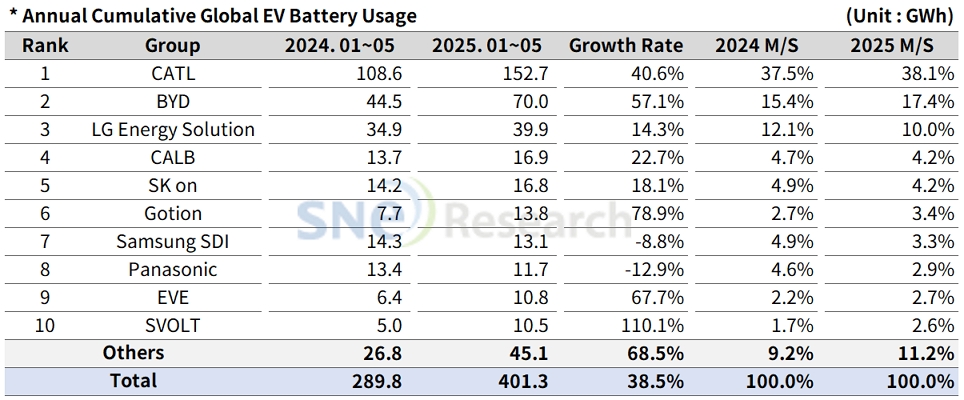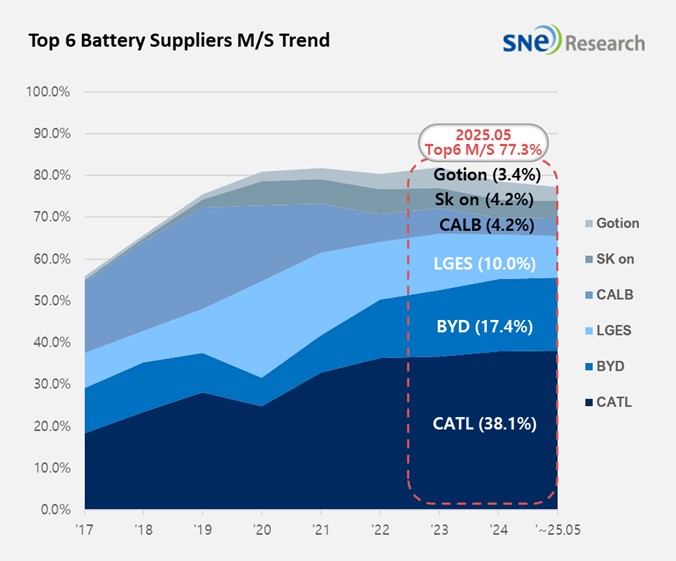From Jan to May in 2025, Global[1] EV Battery Usage[2] Posted 401.3GWh, a 38.5% YoY Growth
- From Jan to May in 2025, K-trio’s M/S recorded 17.4%
From Jan to
May in 2025, the amount of energy held by batteries for electric vehicles (EV,
PHEV, HEV) registered worldwide was approximately 401.3GWh, a 38.5% YoY growth.

(Source: 2025 June Global Monthly EV and Battery Monthly Tracker, SNE Research)
The combined market shares of LG Energy Solution, SK On, and Samsung SDI in global electric vehicle battery usage from Jan to May 2025 posted 17.4%, a 4.5%p decline from the same period last year. LG Energy Solution kept the 3rd position in the ranking with 14.3%(39.9GWh) YoY growth. While SK On ranked 5th with a 18.1%(16.8GWh) growth, Samsung SDI posted an 8.8%(13.1GWh) degrowth. The downward trend in Samsung SDI’s battery usage was mainly caused by a decline in demand for batteries from major car OEMs in Europe and North America.

(Source: 2025 June Global Monthly EV and Battery Monthly Tracker, SNE Research)
If we look at the usage of battery made by the K-trio in terms of the sales volume of models, Samsung SDI’s battery was mainly supplied to BMW, Audi, and Rivian. Although favorable sales of BMW i4 and i5 have brought about a positive impact on the usage of SDI’s battery, declining sale of Audi Q8 e-Tron and application of LFP battery, made by other cell makers, to the standard trim of Rivian has affected negatively.
SK On’s battery was mainly installed to electric vehicles made by Hyundai Motor Group, followed by Ford, Mercedes-Benz and Volkswagen. Hyundai Motor Group saw a recovery in sales of IONIQ 5 and EV 6, and Ford’s F-150 Lightning continued to be sold well in North America. along with this, favorable sales of VW ID.4 and ID.7 in Europe have brought about a positive impact to increase the usage of battery made by SK On.
LG Energy Solution’s battery was mainly used by Tesla, followed by Chevrolet, Kia, and Volkswagen. In case of Tesla, the declining sales of models equipped with LG Energy Solution’s batteries led to a 13.3% decrease in Tesla’s usage of LG Energy Solution’s batteries. Particularly in the European market, while the sales of electric vehicles made by the Chinese OEMs has expanded, demand for Tesla has decreased, which can be regarded as a major reason for the declining usage of LG Energy Solution’s batteries by Tesla. Meanwhile, the total usage grew by 14.2% due to favorable sales of VW’s ID series and Kia’s EV 3 and expanded sales of Chevrolet Equinox, Blazer, and Silverado EVs, built on the Ultium platform, in North America.
Panasonic, which mainly supplies batteries to Tesla, ranked 8th on the list with a battery usage of 11.7GWh. Panasonic has been working to restructure its supply chain in response to the recently fortified US tariffs on the Chinese batteries and raw materials and is implementing a strategy to increase the proportion of local production within the North American region. To be specific, Panasonic is trying to expand its local production to deal with the US tariffs against China and diversify its material supply chain. These efforts are expected to lead to a recovery in the usage of batteries made by Panasonic and enhance the stable operation in the North American region onwards.
CATL remained top in the global battery usage ranking, recording a 40.6%(152.7GWh) YoY growth. Key Chinese OEMs such as ZEEKR와 AITO, Li Auto, and Xiaomi adopted CATL’s batteries, and many global major OEMs, including Tesla, BMW, Mercedes-Benz, and Volkswagen, are also using CATL’s batteries.
BYD ranked 2nd on the list with a growth rate of 57.1%(70.0GWh). BYD, which manufactures both batteries and electric vehicles (BEV+PHEV) in-house, has been received well in the market by introducing a variety of electric vehicles, leveraging its strong price competitiveness. In 2025, BYD’s electric vehicle sales are expected to reach approx. 5.50 million units, and by staying in an upward trend, BYD is expected to continuously expand its global market share.

(Source: 2025 June Global Monthly EV and Battery Monthly Tracker, SNE Research)
From Jan to May in 2025, the global EV market has seen a marked recovery mainly in Europe. To be specific, with the fortified regulations on CO₂ emission, the electric vehicle sales have shown a more than double-digit growth rate in major countries such as Germany and the UK. On the other hand, the US saw a slowdown in preemptive demand for purchase despite the possibility of reducing the tax credit offered for electric vehicles. China, which has been in an upward trend thanks to ‘Old-for-New Replacement Policy,’ has been facing a risk of intensifying price competition caused by overstock. Since the inauguration of President Trump, the US has been going through numerous changes in policies such as the early termination of the IRA, revocation of executive order setting a goal for electric vehicles, and passage of tax reduction bill. Such abrupt changes in the US have been posing a significant impact on the global EV supply chain and market demand. Those policy changes have also led to an overall decrease in the export of battery cells and materials from Korea. In this regard, it is necessary for the K-battery companies to establish their defense measures against a possible risk from the US policy changes and intensified competitions in Europe. Plus, in the mid-to-long term, they are required to restructure themselves to secure future demand from those regions.
[2] Based on battery installation for xEV registered during the relevant period.

